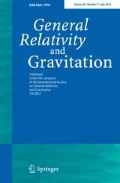Abstract
We find a new homogeneous solution to the Einstein-Maxwell equations with a cosmological term. The spacetime manifold is \(\mathbf{R}\times \mathbf{S}^3\). The spacetime metric admits a simply transitive isometry group \(G = \mathbf{R} \times \mathbf{SU(2)}\) and is Petrov type I. The spacetime is geodesically complete and globally hyperbolic. The electromagnetic field is non-null and non-inheriting: it is only invariant with respect to the SU(2) subgroup and is time-dependent in a stationary reference frame.
Similar content being viewed by others
Notes
Here “symmetry” means a transformation of (g, F) which maps solutions of the field equations to other solutions.
This identity was found by using Maple to construct a Gröbner basis for the polynomials \({\mathcal {R}}_1, \dots , {\mathcal {R}}_6\) in the \(\beta =0\) case. Of course, (3.9) can be verified directly by substituting the expressions for \({\mathcal {R}}_1, \dots , {\mathcal {R}}_6\) (with \(\beta =0\)) and then simplifying.
There are no static families of observers, i.e. hypersurface-orthogonal timelike Killing vector fields.
References
Stephani, H., Kramer, D., MacCallum, M., Hoenselaers, C., Herlt, E.: Exact Solutions of Einstein’s Field Equations, 2nd edn. Cambridge University Press (2003)
Petrov, A.Z.: Gravitational field geometry as the geometry of automorphisms, In: Recent Developments in General Relativity. Pergamon Press, p. 379 (1962)
Kaigorodov, V.: Einstein spaces of maximum mobility Dokl. Akad. Nauk. SSSR 7, 893 (1962)
McLenaghan, R.G., Tariq, N.: A new solution of the Einstein-Maxwell equations. J. Math. Phys. 16, 2306–2312 (1975)
Ozsvath, I.: Homogeneous solutions of the Einstein-Maxwell equations. J. Math. Phys. 6, 1255–1265 (1965)
Ozsvath, I.: New homogeneous solutions of Einstein’s field equations with incoherent matter obtained by a spinor technique. J. Math. Phys. 6, 590 (1965)
Farnsworth, D., Kerr, R.: Homogeneous dust filled cosmological solutions. J. Math. Phys. 7, 1625 (1966)
Ozsváth, I.: Homogeneous solutions of the Einstein-Maxwell equations. J. Math. Phys. 6, 1255 (1965)
Anderson, I.M., Torre, C.G.: Spacetime groups. J. Math. Phys. 61, 072501 (2020)
Waller, S.M.: Bianchi type IX electromagnetic universes. Phys. Rev. D 29, 176 (1984)
McIntosh, C.B.G.: Einstein-Maxwell spacetimes with symmetries and with non-null electromagnetic fields. Gen. Rel. Grav. 9, 277–288 (1978)
Henneaux, M.: Electromagnetic fields invariant up to a duality rotation under a group of isometries. J. Math. Phys. 25, 2276–2283 (1984)
Rainich, G.Y.: Electrodynamics in general relativity. Trans. Am. Math. Soc. 27, 106 (1925)
Krongos, D., Torre, C.G.: Geometrization conditions for perfect fluids, scalar fields, and electromagnetic fields. J. Math. Phys. 56, 072503 (2015)
Cotsakis, S.: Global hyperbolicity of sliced spaces. Gen. Rel. Grav. 36, 1183–1188 (2004)
Acevedo, M.A.M., Lòpez Bonilla, J.: Algebraic classification of the gravitational field. Gen. Rel. Grav. 37, 627–628 (2005)
Anderson, I.M., Torre, C.G.: New symbolic tools for differential geometry, gravitation, and field theory. J. Math. Phys. 53, (2012)
Acknowledgements
This work was supported in part by National Science Foundation grant ACI-1642404. The bulk of the computations were performed with the assistance of the DifferentialGeometry software package [17]. Data sharing is not applicable to this article as no datasets were generated or analysed during the current study.
Author information
Authors and Affiliations
Corresponding author
Additional information
Publisher's Note
Springer Nature remains neutral with regard to jurisdictional claims in published maps and institutional affiliations.
A Petrov type
A Petrov type
In this appendix we give the details of the determination of the Petrov type of the solution.
According to the results, e.g., in references [1, 16], in order to prove that the spacetime investigated here has Petrov type I it is sufficient to establish that
where the scalar invariants I and J are given in terms of the Newman-Penrose Weyl scalars by
Using the null tetrad constructed from the vector fields in (4.3) according to
the Weyl scalars are given by
Using (3.39) we obtain
Rights and permissions
About this article
Cite this article
Anderson, I., Torre, C. A new non-inheriting homogeneous solution of the Einstein-Maxwell equations with cosmological term. Gen Relativ Gravit 54, 27 (2022). https://doi.org/10.1007/s10714-022-02913-8
Received:
Accepted:
Published:
DOI: https://doi.org/10.1007/s10714-022-02913-8



